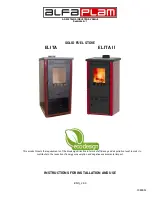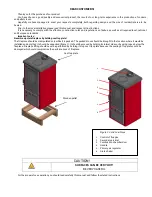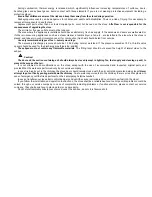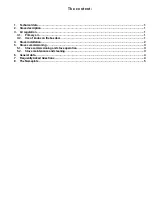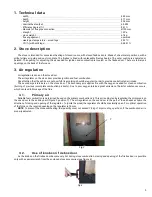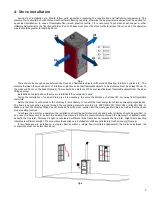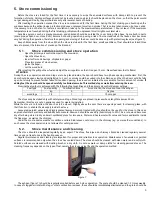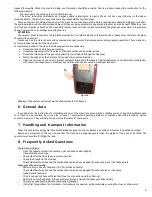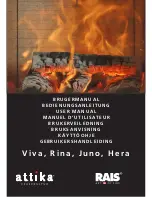
4
cleaned thoroughly. When it comes to stoking, soot formation should be avoided. Soot is produced during the combustion for the
following reasons:
- Poor draught in the chimney (poor-quality chimney)
- The stove is handled improperly, eg. oxygen supply is interrupted too early. We do not have any influence on the above
mentioned facts. Therefore, we cannot assume any responsibility for clean glass.
Glass on the door should be cleaned only if the stove has cooled down, with a cloth or newspaper soaked and dipped into ashes;
the contaminated parts should be wiped down until they are clean completely. Regular detergents can also be used. While the stove
is in function, the glass should not be cleaned for safety reasons! Under normal conditions the glass becomes dark in the ignition
phase; however the color disappears during the use.
ATTENTION
The ceramic glass is resistant to high temperatures, but it could break due to thermal shock or heavy blow, therefore the glass
should not be punched.
Cracks seen on the metal-sheet surface are created under normal thermal expansion during regular operation. These cracks do
not compromise the work of the stove at all.
For optimal operation of the stove the following actions are necessary:
Occasional and comprehensive cleaning,
Occasional cleaning of the flue pipe to eliminate smoke and possible residue,
Occasional cleaning of flue gas compartments (from firebox through the flue pipe),
Empty the ashpan on the bottom of stove and remove all ash residue,
Clean the chimney once a year to prevent sediment formation, otherwise in high temperatures such sediments could ignite,
with severe consequences to the chimney and the entire house caused by improper behavior.
Figure 8
Shaking of the grate is performed via the knobspresented on figure 5.
6.
General data
If you adhere to the instructions for installing and use of the stove, this stove will be a reliable source of heat. All problems with
Your stove can be resolved by our service. In case of complaints regarding problems or mistakes about the functions, please
contact our service. They will help You as well as for orders of spare parts.
7.
Handling and transport information
When the oven is moved, special care must be taken to keep the oven in balance, so sudden movements should be avoided.
Before any movement of the oven, check that the truck has a capacity greater than the weight of the oven to be lifted: the
operator is responsible for lifting the load.
8.
Frequently Asked Questions
The ignition problems:
-
Open the primary air and if necessary, open the ashpan door slightly,
-
Use well-dried wood logs,
-
Check whether the flue pipes are well-connected,
-
Check the draught in the chimney,
-
Check whether the ashes and the combustion residue have clogged the exhaust pipes or the firebox grate.
Glass gets dirty very quickly:
-
Wet wood logs: use dry firewood (10-20% relative humidity),
-
Check whether the ashes and the combustion residue have clogged the exhaust pipes or the grate,
-
Inappropriate firewood,
-
The stove does not have sufficient pull (see the connection and the chimney),
-
Setting is not well-adjusted: if the secondary air inlet is closed, the glass gets dirty quickly,
-
There is a condensate inside the combustion chamber,
-
In the first few ignitions the formation of condensate is expected, as the materials covering the stove contain moist,

